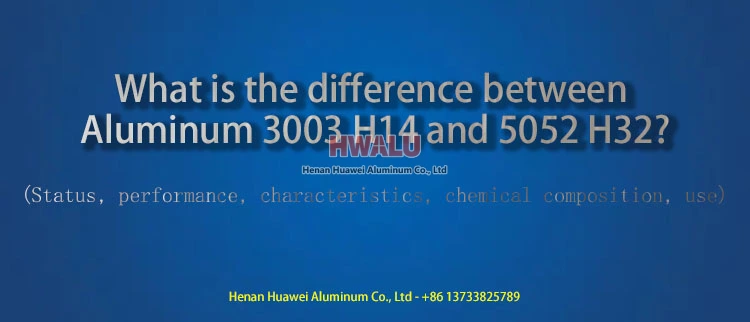Aluminum plate status:
3003-H14
5052-H32
chemical composition:
3003
| Al |
Cu |
Fe |
Mn |
Si |
Zn |
Residuals |
| 96.8 to 99% |
0.05 to 0.20% |
0.7%max |
1.0 to 1.5% |
0.6% max |
0.1% max |
0.15% max |
Data reference: Wikipedia – 3003 aluminum alloy
5052
| Mg |
Cr |
Cu |
Fe |
Mn |
Si |
Zn |
Remainder |
| 2.2%-2.8% by weight |
0.15%-0.35% max |
0.1% max |
0.4% max |
0.1% max |
0.25% max |
0.1% max |
Aluminum |
Data reference: Wikipedia – 5052 aluminum alloy
Mechanical behavior:
3003-H14
Tensile strength: 145-195σb (MPa)
Conditional yield strength: ≥85σb (MPa)
5052-H32
Tensile strength: 173~244σb (MPa)
Yield strength: ≥70σb (MPa)
performance advantage
3003 – Corrosion resistance: 3003 aluminum plate has very good corrosion resistance, close to the corrosion resistance of industrial pure aluminum, and has good corrosion resistance to atmosphere, fresh water, sea water, food, organic acid, gasoline, neutral inorganic salt solution, etc. , the corrosion resistance in dilute acid is also very good.
In the state of cold deformation, 3003 aluminum alloy has a tendency of exfoliation corrosion, and the greater the deformation, the more serious the exfoliation. Due to the uneven color after anodizing, it is generally not anodized.

aluminum 3003 h14 vs 5052 h32
5052 – Corrosion resistance, high temperature resistance, extreme cold resistance, good performance in supporting gas welding, arc welding, resistance welding, spot welding, seam welding, crystallization cracks tend to appear in two argon arc welding. The brazing performance is still good, but the soft soldering performance is poor.
3003 heat treatment process:
1) Complete annealing: heating at 390-430°C; depending on the effective thickness of the material, the holding time is 30-120min; cooling with the furnace to 300°C at a speed of 30-50°C/h, and then air-cooling.
2) Rapid annealing: heating at 350-370°C; depending on the effective thickness of the material, the holding time is 30-120min; air or water cooling.
3) Quenching and aging: quenching at 500-510°C, air cooling; artificial aging at 95-105°C, 3h, air-cooling; natural aging at room temperature for 120h
The state of 5052h32 is an annealing process that accounts for a relatively large proportion of the entire use. This annealing temperature is generally directly annealed at 420-475 degrees, which has the advantages of high temperature resistance, corrosion resistance, and oxidation resistance.
use
3003 – Commonly used in ships, warships, vehicle materials, automobile and aircraft plate weldments, pressure vessels requiring strict fire protection, refrigeration devices, TV towers, drilling equipment, transportation equipment, missile components, armor, etc.
5052 – Used in the manufacture of aircraft fuel tanks, oil pipe fuel tanks, and transportation vehicle shells, sheet metal parts of ships, instruments, street lamp brackets and rivets, hardware products, electrical shells, etc.
